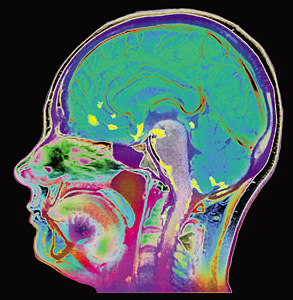Meningitis, << `mehn` ihn JY tihs, >> is a disease that affects the membranes covering the brain and spinal cord. These membranes are called the meninges. The disease also affects the cerebrospinal fluid, which surrounds the brain and spinal cord. Meningitis results from infection by bacteria, viruses, or fungi. This article discusses bacterial and viral meningitis, the two most common forms of the disease.

Meningitis can attack people of all ages. Most victims recover completely from the disease. However, bacterial meningitis can cause severe brain damage and even death. Bacterial meningitis also can result in deafness, paralysis, muscle weakness, intellectual disability, blindness, and changes in behavior.
People with physical conditions that weaken the body’s resistance to infection have the greatest risk of getting meningitis. This group includes people undergoing chemotherapy (the use of drugs to treat cancer) and those who have sickle cell anemia, lack a spleen, or lack infection-fighting proteins called immunoglobulins.
How meningitis develops.
In most cases, the bacteria or viruses that cause meningitis inhabit the nose, throat, and respiratory organs. The microbes pass into the bloodstream and are carried to the brain, where they infect the meninges and the cerebrospinal fluid. A variety of chemical changes occur in the brain, and the brain may swell.
Many types of bacteria cause meningitis. But most cases of bacterial meningitis result from infection by one of three types of bacteria—Neisseria meningitidis, Haemophilus influenzae type b, and Streptococcus pneumoniae. Several viruses also cause meningitis, including a group of common viruses called enteroviruses and the herpes simplex virus that causes cold sores.
Symptoms and diagnosis.
The symptoms of meningitis vary with the age of the patient. Among infants and young children, the symptoms include fever, nausea, vomiting, loss of appetite, and sleepiness. Some children experience seizures or uncontrollable jerking of the limbs. Among older children and adults, symptoms often include severe headache, back pain, muscle aches, seizures, sensitivity to light in the eyes, and altered mental state. Many victims also have a stiff neck.
Doctors diagnose meningitis by examining a sample of the patient’s cerebrospinal fluid. The sample is obtained by inserting a needle between the vertebrae in the lower part of the back. This procedure is known as a lumbar puncture or spinal tap. The cerebrospinal fluid of victims of bacterial meningitis contains a high level of protein and a low level of glucose. The fluid of most patients with viral meningitis has a normal or high level of protein and a normal level of glucose. To identify the type of bacterium or virus involved, the patient’s cerebrospinal fluid is further tested in various ways.
Treatment and prevention.
Bacterial meningitis is treated with antibiotics, which greatly reduce the risk of dying from the disease. The antibiotic used depends on the bacteria involved. Antiviral drugs may be used to treat some types of viral meningitis. Most patients recover from meningitis in several weeks.
Some forms of bacterial and viral meningitis are contagious. Rifampin, an antibiotic, helps protect against the spread of meningitis caused by Neisseria meningitidis and Haemophilus influenzae type b. Doctors usually administer rifampin to people who come into close respiratory contact with a meningitis patient, such as through coughing or kissing. There are vaccines to protect against certain types of bacterial meningitis. Doctors recommend that all infants be vaccinated for Haemophilus influenzae type b meningitis. There are no effective ways to prevent viral meningitis.
